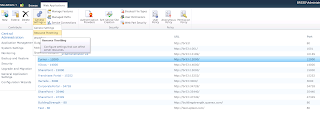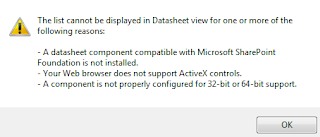Webparts adding to existing page and their custom property values which are meta data.
What i have done here is created powershell script to get taxonomy values like term store.
powershell script will ask for central admin URL and Termstore name.
1: Add-PSSnapin Microsoft.SharePoint.PowerShell
2: #read parameters from command line
3: $CurrentDir= Split-Path -parent $MyInvocation.MyCommand.Definition
4: $timeStamp = (Get-Date).ToString("yyyyMMddhhmmss")
5: $logFile = $CurrentDir+ "\install_" + $timeStamp + ".log"
6: start-transcript -path $logFile -noclobber
7: $url = Read-Host "Enter Central admin url"
8: #$url = "http://br66:14209/"
9: #$site = Get-SPSite -Identity "http://br66:14209/"
10: $web = Get-SPWeb $url
11: $taxonomySession = Get-SPTaxonomySession -Site $web.Site
12: $termStoreName = Read-Host "Enter TermStore Name"
13: $termStore = $taxonomySession.TermStores[$termStoreName];
14: Write-Host $termStore.Name $termStore.Id
1: foreach($item in $termStore.Groups)
2: {
3: Write-Host $item.Name
4: foreach($term in $item.TermSets)
5: {
6: if($term.Name -eq "Site Section")
7: {
8: Write-Host $term.Name
9: $group = $term
10: Write-Host ": " $group.Name $group.Id
11: foreach($termSetUnit in $term.Terms)
12: {
13: if($termSetUnit.Name -eq "Test and Measurement")
14: {
15: Write-Host $termSetUnit.Name
16: foreach($termset1 in $termSetUnit.Terms)
17: {
18: Write-Host $termset1.Name
19: $TermName = $termset1
20: Write-Host ": " $TermName.Name $TermName.Id
21: }
22: }
23: }
24:
25: }
26: }
27: }
With this one text file will generate and copy and paste values in config file
1: <?xml version="1.0" encoding="utf-8" ?>
2: <ContentDeploymentConfig xmlns:xsi="http://www.w3.org/2001/XMLSchema-instance" xmlns:xsd="http://www.w3.org/2001/XMLSchema">
3: <SourceSite>http://br66:50001</SourceSite>
4: <LastRunTime>2013-01-01T12:00:00Z</LastRunTime>
5: <FeatureId>6717c859-64c8-4f7a-bfc0-873256087ac8</FeatureId>
6: <TaxonomyStoreID>0ded38c7-c349-4638-8ce8-e564fdd44922</TaxonomyStoreID>
7: <TaxonomySetID>ddb6225b-471c-4a6c-853f-bf4686dc88e6</TaxonomySetID>
8: <TaxonomyProductGUID>Products|9b34e73d-d4c2-4680-bd8c-5343f4b66463</TaxonomyProductGUID>
9: <TaxonomyServiceGuid>Services|bc612c4e-3267-4c6f-9ff1-0e99726e802f</TaxonomyServiceGuid>
10: <Countries>
11: <Japan>ja-jp</Japan>
12: <China>zh-cn</China>
13: <poland>pl-pl</poland>
14: <Russia>ru-ru</Russia>
15: <Germany>de-de</Germany>
16: <Spain>es-es</Spain>
17: <Brazil>pt-pr</Brazil>
18: <UnitedStates>en-us</UnitedStates>
19: </Countries>
20: </ContentDeploymentConfig>
Above red marked values i got from script.
After getting this values add webparts to existing pages of site.
Your page should be checked out above spmgr else it will not do checked out if it is written inside.
1: if (pageCategory.CheckOutType == SPFile.SPCheckOutType.None)
2: {
3: pageCategory.CheckOut();
4: }
5: SPLimitedWebPartManager spmgr = sourceProductsWeb.GetLimitedWebPartManager(pageCategory.Url.ToString(), PersonalizationScope.Shared);
6: string exportedWebPartXml = string.Empty;
7: if (WebpartTitle == "EngagementProductLinks")
8: {
9: exportedWebPartXml = new StringReader(sourceSite.RootWeb.GetFileAsString(sourceSite.RootWeb.Url + "/_catalogs/wp/EngagementProductLinks.webpart")).ReadToEnd();
10: }
11: else if (WebpartTitle == "RightColumnPromotions")
12: {
13: exportedWebPartXml = new StringReader(sourceSite.RootWeb.GetFileAsString(sourceSite.RootWeb.Url + "/_catalogs/wp/RightColumnPromotions.webpart")).ReadToEnd();
14: }
15: XmlTextReader reader = new XmlTextReader(new StringReader(exportedWebPartXml));
16: System.Web.UI.WebControls.WebParts.WebPart importedWp = spmgr.ImportWebPart(reader, out outmessage);
17: String spmgrWebPartTitle = string.Empty;
18: if (spmgr != null)
19: {
20: for (int j = 0; j < spmgr.WebParts.Count; j++)
21: {
22: spmgrWebPartTitle = spmgr.WebParts[j].Title;
23: if (spmgrWebPartTitle != WebpartTitle)
24: {
25: if (spmgr.GetZoneID(spmgr.WebParts[j]) == "ContactsZone")
26: {
27: countwebparts++;
28: }
29: }
30: if (spmgrWebPartTitle == WebpartTitle)
31: {
32: if (spmgr.GetZoneID(spmgr.WebParts[j]) == "ContactsZone")
33: {
34: sourceProductsWeb.AllowUnsafeUpdates = true;
35: spmgr.DeleteWebPart(spmgr.WebParts[j]);
36: pageCategory.Update();
37: sourceProductsWeb.AllowUnsafeUpdates = false;
38: }
39: }
40:
41: if (spmgrWebPartTitle.Equals("Promotion Right Column"))
42: {
43: if (spmgr.GetZoneID(spmgr.WebParts[j]) == "ContactsZone")
44: {
45: sourceProductsWeb.AllowUnsafeUpdates = true;
46: WriteLog("found");
47: spmgr.DeleteWebPart(spmgr.WebParts[j]);
48: pageCategory.Update();
49: sourceProductsWeb.AllowUnsafeUpdates = false;
50: }
51: }
52: }
53: }
54: sourceProductsWeb.AllowUnsafeUpdates = true;
55: try
56: {
57: if (pageCategory.CheckOutType == SPFile.SPCheckOutType.None)
58: {
59: pageCategory.CheckOut(); }
60:
61: importedWp.ChromeType = PartChromeType.None;
62: spmgr.AddWebPart(importedWp, "ContactsZone", index);
63: spmgr.SaveChanges(importedWp);
64: PropertyInfo[] SiteSecitonProperty = importedWp.GetType().GetProperties(BindingFlags.NonPublic | BindingFlags.Public | BindingFlags.Instance);
65: foreach (PropertyInfo sitesection in SiteSecitonProperty)
66: {
67: if (sitesection.Name == "SiteSectionTaxonomy")
68: {
69: sitesection.SetValue(importedWp, GUID, null);
70: spmgr.SaveChanges(importedWp);
71: }
72: else if (sitesection.Name == "TermStoreID")
73: {
74: string TermStoreguid = ContentDeploymentConfigObj.TaxonomyStoreID;
75: System.Guid guid = new Guid(TermStoreguid);
76: sitesection.SetValue(importedWp, guid, null);
77: spmgr.SaveChanges(importedWp);
78: }
79: else if (sitesection.Name == "TermSetID")
80: {
81: string TermSetguid = ContentDeploymentConfigObj.TaxonomySetID;
82: System.Guid guid = new Guid(TermSetguid);
83: sitesection.SetValue(importedWp, guid, null);
84: spmgr.SaveChanges(importedWp);
85: }
86: else if (sitesection.Name == "Text")
87: {
88: sitesection.SetValue(importedWp, GUID, null);
89: spmgr.SaveChanges(importedWp);
90: }
91: }
92: pageCategory.CheckIn(" Added Web Part " + importedWp.Title);
93: }
94: catch (Exception ex)
95: {
96: WriteLog("Error " + ex.Message + "Page is " + pageCategory.Title);
97: WriteLogFile(false, ex.Message + sourceProductsWeb.Url.ToString() + "/" + pageCategory.Url.ToString() + " giving error in site ");
98: if (pageCategory.CheckOutType == SPFile.SPCheckOutType.Online)
99: {
100: pageCategory.CheckIn("Checkin");
101: }
102: }
103: sourceProductsWeb.AllowUnsafeUpdates = false;
Above code is to add webparts and properties value to webparts.





